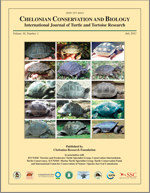We report on data collected during the first long-term turtle monitoring and conservation program conducted in the Amirantes Islands Group of Seychelles. Green turtle (Chelonia mydas) and hawksbill (Eretmochelys imbricata) nesting activity was recorded on a daily basis, year-round, over a period of 62 months between November 2004 and December 2009 at D'Arros Island, in the context of a community-based turtle monitoring and conservation program coordinated by the D'Arros Research Centre (DRC). Green turtle nesting occurred year-round with a distinct peak in late March but also evidence of a bimodal pattern with a dominant peak during February to April and a secondary peak in July and August. For hawksbills, nesting peaked in early December, with 94.0% of nesting emergences during the four-month interval from 1 October to 31 January. Along the 5-km nesting beach, the estimated average number of clutches laid annually was 95 for green turtles (range 65–120) and 300 (range 277–318) for hawksbills. Assuming an average of 5 clutches annually for green turtles and 4–5 for hawksbills, this would represent some 20 green turtles and 60–75 hawksbill females nesting annually. This indicates an increase in nesting activity—but not necessarily in numbers of nesting females—from that reported in the early 1970s, early 1980s, and mid-1990s when exploitation was intense. During the 5 years that the DRC turtle conservation and monitoring program was underway, turtle poaching has virtually ceased at D'Arros Island and adjacent St. Joseph atoll.
How to translate text using browser tools
1 July 2011
Seasonality and Status of Nesting Hawksbill (Eretmochelys imbricata) and Green Turtles (Chelonia mydas) at D'Arros Island, Amirantes Group, Seychelles
Jeanne A. Mortimer,
Jean-Claude Camille,
Nigel Boniface
ACCESS THE FULL ARTICLE

Chelonian Conservation and Biology
Vol. 10 • No. 1
July 2011
Vol. 10 • No. 1
July 2011
Amirantes Islands Group
breeding population size
Chelonia mydas
Cheloniidae
Community conservation
D'Arros Island
Eretmochelys imbricata




